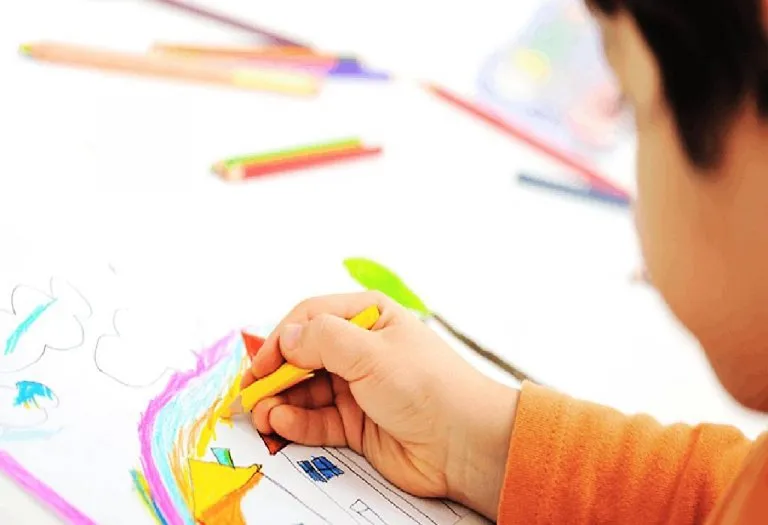6 Genius Ideas To Teach Kids To Color Within The Lines
Many parents wonder about how and when how to teach a child to colour inside the lines. Learning to colour within the lines helps in developing the fine motor skills of your child. We help you figure out how to guide your little artist!
Little kids are still developing different skills and will more often than not mess up certain tasks. Your little Picasso will frequently colour out of the lines as he plays with his art supplies, but as parents, our guidance for our little ones is what helps them learn new skills. Colouring within the lines helps improve the fine motor skills of your child. This activity requires eye-hand coordination and significant hand strength to color in a regulated way. Besides, learning to color within the lines also helps enhance the writing skills of your little learner since writing too is confined to a limited space. If you’re worried about how to teach your kid to colour within the lines, we’ve got you covered.
At What Age Should You Start Teaching Your Child to Color Within the Lines?
When do kids color in the lines? Children typically start to develop the ability to color within the lines around the age of 3 to 4 years old. However, it’s important to note that every child develops at their own pace, so some may begin earlier or later.
Following is how you can guide your child at different ages:
- Age 2-3: Children at this age are usually engaged in scribbling and experimenting with different colors. They may not yet show an interest in coloring within the lines but are beginning to explore art materials.
- Age 3-4: This is when children start to develop more control over their hand movements and can begin to color within the lines. They may still need assistance and guidance from adults but are showing progress in their fine motor skills.
- Age 4-5 and beyond: As children continue to practice and refine their coloring skills, they become more proficient at staying within the lines and may even start to add more detail and complexity to their drawings.
It’s important to approach this process with patience, encouragement, and a focus on the enjoyment of the activity rather than strict adherence to staying within the lines.
What Are the Advantages of Teaching Kids to Color Inside the Lines?
Teaching kids to color inside the lines can have various benefits for their development and learning. By mastering this skill, children improve their fine motor skills, hand-eye coordination, concentration, creativity, and confidence. Here are some advantages in more detail:
1. Fine Motor Skills Enhancement
Coloring within the lines requires precise hand movements, which helps children develop and strengthen their fine motor skills. This improvement can aid them in various activities such as writing, tying shoelaces, and using utensils.
2. Hand-Eye Coordination Improvement
Coordinating hand movements with visual information is essential for coloring inside the lines. This activity enhances hand-eye coordination, which is crucial for tasks like catching a ball, playing musical instruments, and even driving.
3. Focus and Concentration Development
Coloring inside the lines encourages children to concentrate on the task at hand, promoting the development of focus and concentration skills. This ability to sustain attention is beneficial for academic learning and everyday tasks that require concentration.
4. Stimulates Creativity
While coloring inside the lines requires precision, it also leaves room for creativity within those boundaries. Children can experiment with different color combinations, shading techniques, and artistic expressions, fostering their creativity and imagination.
5. Boosts Confidence
Mastering the skill of coloring within the lines provides a sense of accomplishment and boosts children’s confidence in their abilities. As they see their progress and the results of their efforts, they become more confident in tackling new challenges and tasks in various aspects of their lives.
Ways to Teach Your Kids to Color Inside the Lines
Teaching kids to color inside the lines can be a fun and rewarding activity that helps develop their fine motor skills and hand-eye coordination. Here are some effective ways to encourage this skill:
1. Teach Your Kid the Right Way to Hold and Move Brushes
Provide your little painter with big and small brushes and food colors and invite him to explore color blobs that he can create on a clear sheet of paper. Teach your kid to hold small sized brushes near the tip and large-sized brushes away from the tip so that he can move them conveniently in a controlled manner. Colouring with big brushes teaches him the right way to hold larger colouring tools and move them effectively to colour within the marked space.
2. Develop Their Hand Strength and Coordination
Colouring within the lines is possible only when your child has substantial hand strength and improved eye-hand coordination. So, you need to build your little painter’s hand strength by engaging him in hand strengthening activities, such as grasping and moving small items and pinching soft objects like pillows. Also, making your growing kid squeeze a spray bottle helps improve his hand strength substantially. Provide your kids big tweezers and tell him to pick up various objects using it. This helps improve hand strength and hand-eye coordination substantially.
3. Provide Images With Big Borders
In the initial stages of painting and colouring, encourage your child to colour images having big borders as it helps your child learn to colour more easily. As your child’s coloring skills improve, gradually encourage him to move on to colour within thinner borders.
4. Offer Them a Variety of Colouring Tools
Introduce your kids to a vast variety of crayons of different sizes ranging from thin, skinny-sized ones to thick, large-sized crayons. Let your child choose which size of crayon he finds easy to hold and colour with in a controlled manner. Also, you can provide several colour markers – each of different size – and let your kid choose his most preferred one. Letting your kid choose a colouring tool that he can manage the best promotes the skill of colouring within the lines.
5. Encourage Them To Colour Often
Provide your child simple pictures and guide them to colour them within the lines. Initially, hold your kid’s hand and teach him how to colour within the marked lines without letting the colour spread outside the lines. Encourage your kid to draw different sized pictures and colour them within the lines more often. Practice helps hone your child’s colouring skills and lets him develop better control over his painting abilities.
6. Reward With Colouring Books
As your child practices colouring within the lines, boost his morale by gifting him colouring books and colouring sheets comprising pictures with intricate details. Appreciating his efforts by rewarding him with colouring books will motivate him to colour more images and more skillfully too, i.e., within the lines.
FAQs
1. What are some practical tips for teaching kids to color within the lines?
Provide coloring sheets with bold outlines. Encourage them to start with larger shapes before moving to smaller details. Use highlighters or markers to emphasize the boundaries they should color within. Offer verbal prompts and demonstrations to guide their hand movements.
2. How can I make coloring activities more engaging for my child?
Use themed coloring books or pages related to their interests (e.g., animals, superheroes). Incorporate storytelling while they color, encouraging them to create narratives around their artwork. Experiment with different coloring materials such as crayons, colored pencils, or markers to keep it interesting.
3. Should I correct my child’s mistakes while they’re coloring?
Offer gentle guidance and encouragement rather than focusing solely on correcting mistakes. Highlight their progress and celebrate their efforts, regardless of imperfections. Encourage them to keep practicing and reassure them that improvement comes with time and practice.
4. How can I encourage my child to stay focused during coloring activities?
Set aside a designated time and space for coloring without distractions. Break down the task into smaller segments and offer short breaks if needed. Use positive reinforcement, such as praise or rewards, to motivate them to stay focused and engaged.
In conclusion, mastering the skill of coloring within the lines is not only about precision but also about fostering creativity and confidence in children. By employing these genius ideas and techniques, parents and educators can create enjoyable and enriching experiences that support children’s development in fine motor skills, hand-eye coordination, concentration, and artistic expression. Remember to celebrate progress, encourage perseverance, and most importantly, cherish the creative journey with your child. With patience, practice, and a sprinkle of imagination, children can flourish in their artistic endeavors while having loads of fun along the way.
Also Browse Coloring Pages:
Simple Colouring Pages for Kids
Birds Colouring Pages for Toddlers
Cartoons Colouring Pages for Pre-schoolers
Flowers Colouring Pages for Children
Fruits Colouring Pages for Kindergarten
Also Read:
Unicorn Coloring Pages
Colour Activities for Preschoolers
Fun and Educative Color Activities for Kids
How to Teach Colours to Toddlers and Preschoolers?
Was This Article Helpful?
Parenting is a huge responsibility, for you as a caregiver, but also for us as a parenting content platform. We understand that and take our responsibility of creating credible content seriously. FirstCry Parenting articles are written and published only after extensive research using factually sound references to deliver quality content that is accurate, validated by experts, and completely reliable. To understand how we go about creating content that is credible, read our editorial policy here.






















